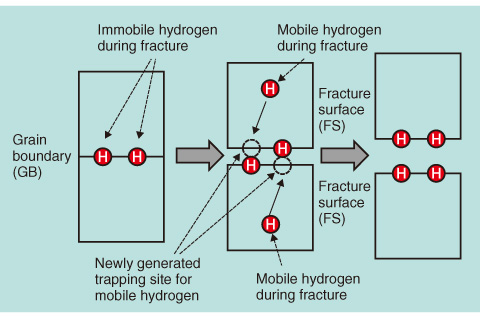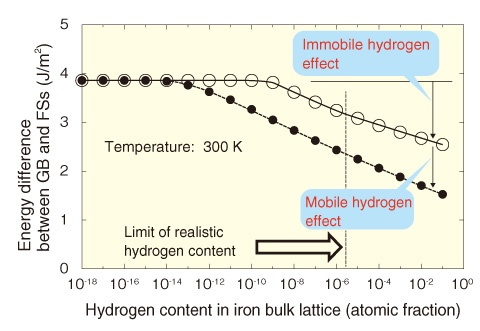
Fig.11-2 Concept of mobile hydrogen

Fig.11-3 Energy difference before and after fracture
Hydrogen-induced embrittlement of steel has been studied for many years, but the mechanism is still not well understood. The wide variety of hydrogen-induced embrittlement implies that there is more than one mechanism. This study focuses on the hydrogen-induced grain boundary embrittlement of high-strength steels. Metallic materials such as steel generally consist of many crystal grains, which are roughly several tens of micrometers in size. The boundary between two grains is called a grain boundary and has disordered atomic structure. It is well known that diffusing hydrogen atoms in the iron lattice can be trapped along the grain boundaries, and then the aggregation (segregation) of hydrogen atoms causes cracking. However, the microscopic (atomistic) mechanism of hydrogen-induced grain boundary embrittlement is still unclear.
We investigated the mechanism by using first principles electronic structure calculations based on quantum mechanics. The results showed that hydrogen atoms can be trapped along grain boundary and fracture surfaces, and then promote cracking along the grain boundaries. Furthermore, we suggested that moving hydrogen in the iron lattice during fracturing assisted the formation of fracture surfaces by being trapped at newly generated atomic sites. This is called the mobile hydrogen effect.
A schematic illustration of the embrittling effect of mobile hydrogen is shown in Fig.11-2. Grain boundary embrittlement is believed to be caused by weakening of atomic bonding across the grain boundary plane. The strength of the bonding is characterized well by the energy difference between the grain boundary and its two fracture surfaces before and after fracturing. This energy difference can be calculated from first principles. We showed that hydrogen segregation along the grain boundary decreases its energy difference, indicating that hydrogen causes embrittlement. Furthermore, hydrogen in iron can diffuse very rapidly and thus can be trapped at newly generated atomic sites on freshly forming fracture surfaces. This can assist the breaking of atomic bonds at the iron grain boundary. Our first principles calculations with a statistical mechanics analysis estimated the embrittling effect of mobile hydrogen for the first time and showed that mobile hydrogen greatly enhances the embrittling effect along grain boundaries in a realistic range of hydrogen content, as shown in Fig.11-3.
<Previous: 11 Computational Science and E-Systems Research | Next: 11-2 >